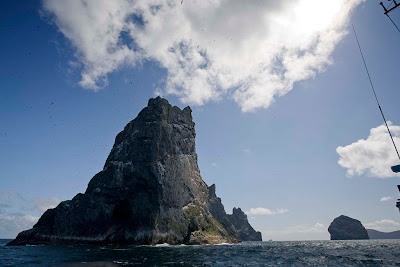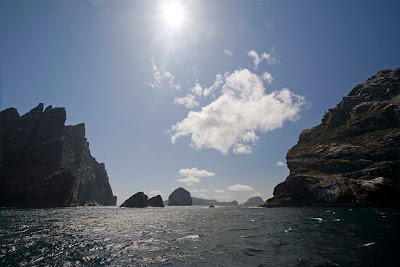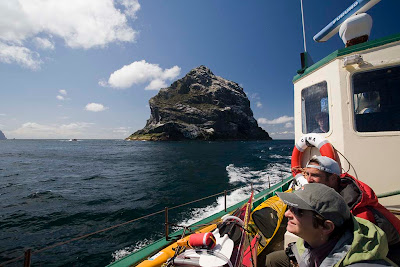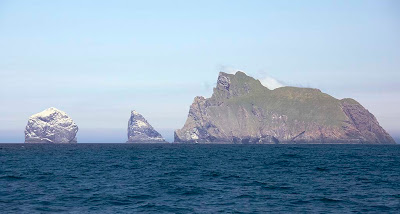The Cuma slowed as we approached the north end of Boreray. We were silenced by this view between Boreray and Stac an Armin. Stc Lee is partly hidden by the dark cliffs of Boreray, Hitra is in the distance with Stac Soay and Stac Biorach between it and Soay, then Stac an Armin.
Telephoto shot of Soay.
At 196m high, Stac an Armin is the highest sea stac in the British Isles. The St Kildans harvested seabird each summer. They built 80 cleits and a bothy on the rock. Three men and eight boys spent 9 months on Stac an Armin from about 15 August 1727 until 13 May 1728 when they were rescued by a boat from the Outer Hebrides. Smallpox had broken out on Hirta after they had been dropped off and there were not enough adult survivors to man a boat to recover them.
Nearby Stac Lee is the second highest stac at 172m.
Stac an Armin from the NW. The last great auk in the British isles was killed here in July 1840. It was caught by three St Kildans and held captive for three days before they beat it to death because they thought it was a witch.
The air was filled by a blizzard of croaking gannets. These islands are one of the biggest sea bird colonies in Europe.
They are incredibly graceful in flight...
...and have a wingspan of 2m.
The Cuma now swung round the south of Stac an Armin. The islanders leaped ashore from their boats at the white water below the highest point.
Track of the Cuma,
Imagine you are at the edge of the sea on a day when it is difficult to say where the land ends and the sea begins and where the sea ends and the sky begins. Sea kayaking lets you explore these and your own boundaries and broadens your horizons. Sea kayaking is the new mountaineering.
Showing posts with label Stac Lee. Show all posts
Showing posts with label Stac Lee. Show all posts
Friday, June 24, 2011
Saturday, June 18, 2011
St Kilda preview!
Looking back to Stac Lee, Stac an Armin and Boreray while en route to Hirta.
Tony and I had planned a week to St Kilda with Murty and Murdani on the MV Cuma at the beginning of June. We were both well pissed off when the University changed the dates of the exam season and we couldn't go. I was then completely gobsmacked when Gordon Brown phoned up and asked if I would like to go on a trip to St Kilda the following week, as he was filming some sequences for his second sea kayaking DVD with Simon Willis. It took me all of 0.3 secs to say yes. There was Gordon, Morag, Simon, Liz, Donald (who led the first return trip to St Kilda by kayak from the Outer Hebrides), Anne, Ken, Callum, Janice, Sue, Ian and myself. Murdani was joined by Gary and Louise on the Cuma.
The company on this trip was real fun and considerate. I was troubled by some bad knee pain on this trip but the thoughtful help with handling of the kayaks and with launching and recovery was really appreciated. When I last visited St Kilda, I didn't venture far from the village as my knee was recurrently dislocating. This time, my knee was totally stable after the operation and I went a walk with the others round the island. All went well until we started to come back downhill. That proved very painful and I fell a long way behind the others. However, Gordon stayed behind with me and we had a great chat. One thing is for sure, I would never have been able to attempt a trip like this without considerable help from other people. Thank you all! :o)
The thrift is still flowering on top of the cleits.
Village street, Hirta.
Soay ram, Hirta.
Bonxie attack Conachair, Hirta. Our near permanent smug mode was temporarily disengaged.
Glen Bay, An Campar and Soay from Mullach Mor, Hirta.
Dun from Ruabhal, Hirta.
West coast of Hirta.
The Cuma and Stac an Armin.
The great cave on the west of Boreray.
Looking back at Stac Lee Hirta and Soay from the north end of Boreray.
Tony and I had planned a week to St Kilda with Murty and Murdani on the MV Cuma at the beginning of June. We were both well pissed off when the University changed the dates of the exam season and we couldn't go. I was then completely gobsmacked when Gordon Brown phoned up and asked if I would like to go on a trip to St Kilda the following week, as he was filming some sequences for his second sea kayaking DVD with Simon Willis. It took me all of 0.3 secs to say yes. There was Gordon, Morag, Simon, Liz, Donald (who led the first return trip to St Kilda by kayak from the Outer Hebrides), Anne, Ken, Callum, Janice, Sue, Ian and myself. Murdani was joined by Gary and Louise on the Cuma.
The company on this trip was real fun and considerate. I was troubled by some bad knee pain on this trip but the thoughtful help with handling of the kayaks and with launching and recovery was really appreciated. When I last visited St Kilda, I didn't venture far from the village as my knee was recurrently dislocating. This time, my knee was totally stable after the operation and I went a walk with the others round the island. All went well until we started to come back downhill. That proved very painful and I fell a long way behind the others. However, Gordon stayed behind with me and we had a great chat. One thing is for sure, I would never have been able to attempt a trip like this without considerable help from other people. Thank you all! :o)
The thrift is still flowering on top of the cleits.
Village street, Hirta.
Soay ram, Hirta.
Bonxie attack Conachair, Hirta. Our near permanent smug mode was temporarily disengaged.
Glen Bay, An Campar and Soay from Mullach Mor, Hirta.
Dun from Ruabhal, Hirta.
West coast of Hirta.
The Cuma and Stac an Armin.
The great cave on the west of Boreray.
Looking back at Stac Lee Hirta and Soay from the north end of Boreray.
Saturday, February 07, 2009
Stac an Armin

Cuma made her way north up the west coast of Boreray and we came to the giant Stac an Armin, at 196m, the tallest of all the British sea stacks.

Stac an Armin is the norther outlier of the St Kildan archipelago looked SW to distant Levenish, Stac Lee and Hirta.

The St Kildans built about 80 cleitean on Stac an Armin.

After rounding the north end of Stac an Armin Cuma made her way SE down the east coast.

The Cuma kept well clear of the rocky channel between Boreray and Stac an Armin. We got a good view of Stac Lee, Hirta and Soay through the gap.

Leaving Stac an Armin in our wake, we looked in awe at the great horns of rock on north cliffs of Boreray. Our visit to the archipelago was soon coming to an end.
03/06/2009 pm
Wednesday, February 04, 2009
Stac Lee

Approaching Stac Lee, every ledge appears to have a thick layer of snow and the sky above seems to be full of swirling snow flakes.

As you get closer, you are confronted by one of the natural wonders of the World. The island is completely covered in noisy gannets. A fifth of the World's northern gannets breed on these isolated blades of rock.

Gannets are large birds with forward facing eyes. They dive from about 50m above the water and can plunge deep under the surface with folded wings in search of fish.

From the side, Stac Lee can be seen to be a thin blade of rock, 172m high. It is remarkable that a party of St Kildans survived here for 9 months (through a winter). They were marooned because a small pox outbreak on Hirta prevented their fellow islanders from picking them up after a bird hunting expedition. Soay is on the horizon.

Looking from the far side of Stac Lee, back towards Dun and Hirta.
03/06/2009
Tuesday, February 03, 2009
To Boreray and the Stacs

About 7km to the NE of Hirta lies one of the most dramatic island groups in Scotland: Boreray and the Stacs. MV Cuma now made her way between Boreray and Stac Lee, round Stac an Armin and then round the far side of Boreray before returning to Harris.

These scraps of land way out in the Atlantic form part of the rim of a volcano which was formed as the plates on either side of the Atlantic Ocean began to separate. Here we see Stac Lee, Stac an Armin and Boreray. The St Kildans visited each of these islands, usually in August, to harvest sea birds. They also kept sheep on Boreray. There are no beaches to land and leave a boat. They were dropped off by a boat heaving up and down in the Atlantic swell and had to climb up the steep rocks above.

Stac Lee and Stac an Armin are the two biggest sea stacks in the British Isles.
03/06/2008 pm
Thursday, January 29, 2009
Between a pox and a hard place on Stac Lee.

From the cliffs on the NE coast of Hirta it is less than 7km across the Atlantic to Boreray and its two satellite stacs. They are Stac Lee and Stac an Armin (in the shade behind). They are the highest stacks in the British Isles. The islanders kept sheep on Boreray and also visited these islands for the sea bird harvest in August. Amazingly there are also about 50 cleitean on Boreray and about 80 on Stac an Armin!
 <
<There were also bothies on all three. The one on Stac Lee can still be found. It is just below the dark "V" under the left of the white stained summit cap of the island. The island and stacs are too exposed to leave a boat, so work parties were dropped off by a boat from Hirta, which would return when a signal indicated the work was done.
In 1729 a smallpox epidemic was started after a St Kildan had died on Harris from smallpox the previous year. As his clothes were still good, they were brought back to St Kilda and the smallpox gripped the population. At the time, three adults and eight boys were marooned on Stac Lee because there were no surviving adults, strong enough to man the boat from Hirta, to rescue them. They remained on this windswept rock for 9 months, through the winter and into the next summer, until the factor's boat from Harris relieved them. When they returned to Hirta, they found only one adult and 18 children had survived the epidemic from the population of nearly 200.
Remarkably St Kilda was repopulated in the 1730's from Harris, Uist and Skye. Life may have been tough on St Kilda but it was even worse for many on these other islands. The incomers were taught how to climb the cliffs and harvest birds by the few survivors. By 1758 the population had risen to 88 but it would never again reach 200. The decline had started.
03/06/2008 am
Tuesday, July 01, 2008
Eyes front for the Old Man of Levenish!

As the St Kilda archipelago slowly heaved above the Atlantic horizon....all eyes were excitedly looking ahead.

The first stack we came to was Levenish. From the south east it looked rather uninteresting compared with its more distant neighbours. Then as we passed by we saw the face of the Old Man of Levenish as clear as day!

Behind Levenish lay the dramatic stacks of Stac Lee, Stac an Armin and the island of Boreray. We had nearly arrived at St Kilda!
02/06/2008






























